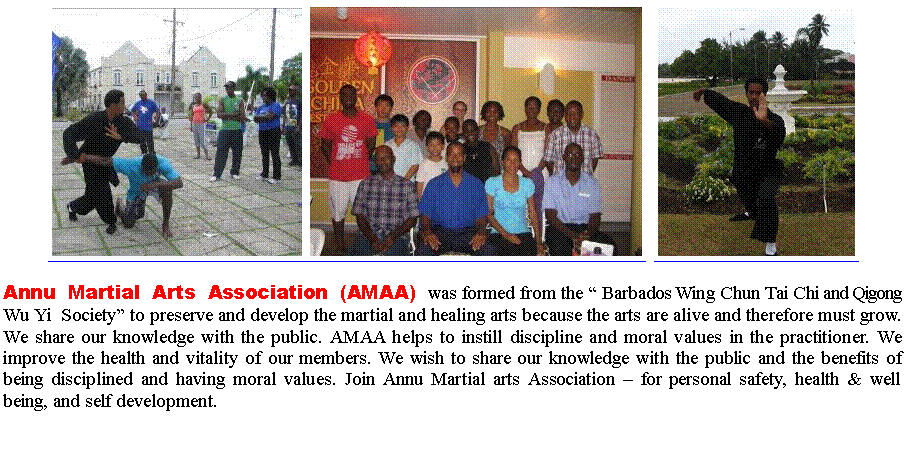Annu Martial Arts Association (AMAA) - Wushu in Barbados
MARTIAL ARTS1. Qigong2. Tai Chi Chuan3. Wing ChunMARTIAL ARTS TEMPLES
In eastern martial society, the success of a student is not determined by his/her external appearance, or by how strong or weak he/she is, but rather by the student's morality and how he/she thinks. Eastern martial artists have a saying: "A student will spend three years looking for a good teacher, and a teacher will test a student for three years." A wise student realizes that it is better to spend several years looking for a good teacher than to spend the time learning from a mediocre one. A good teacher will lead you to the right path, and help you to build a strong foundation for your future training. A teacher who is not qualified, however, will not help you build a strong foundation, and may even teach you bad habits. In addition, good teachers will always set a good example for students with their spiritual and moral virtue. Good martial arts teachers do not teach only martial techniques, they also teach a way of life.
SELF IMPROVEMENT Eastern wisdom for the western world Consistent with it’s roots, kung fu does not in fact mean martial art, boxing or even fighting. The term kung fu, means attainment— A skill achieved through effort over time. Developing fighting ability, or martial kung, is only one element of kung fu. Attainment can also be expressed as learning to remain calm under trying circumstances, to maintain physical constitution against the effects of age or inactivity, or simply improving ourselves through better knowledge of our own abilities. Fortunately, life and death fights are rare these days for most of us. However, these other areas of attainment make kung fu as relevant as ever today – maybe even more so. Mind and Body Metamorphosis: Conditioning Techniques for Personal Transformation Chinese boxing, or kung fu, was first developed by the Shaolin Monks of Northern China as a means to defend themselves from bandits while travelling across the country. The techniques at the root of kung fu were in fact introduced to the monks by Da Mo, a Buddhist monk when he arrived in China from India. Da Mo found the monks to be in such poor condition that he developed a series of breathing exercises for them to practice. Over hundreds of years, these breathing, meditation, boxing and callisthenic exercises evolved into a highly efficient, scientific training system, putting mind and body in a state of readiness for confrontation. There are over one thousand Chinese martial arts practiced in China. Actually, Japanese karate has its origins in Chinese martial arts. AMMA covers the five Categories of fighting techniques: Unarmed: 1. Kicking 2. Hand striking 3. Wrestling & Grappling (Ground fighting) 4. Seizing and controlling Unarmed: 5. Weapons ( bladed weapons, staff/poles; Archery etc)
Variation and scope of Categories of fighting techniques: - Martial arts may be categorized along a variety of criteria, including: · Traditional or historical arts and contemporary styles of folk wrestling vs. modern hybrid martial arts. · Regional origin, eg. Eastern Martial Arts vs. Western Martial Arts and Northern Martial Arts vs. Southern Martial Arts · Techniques taught: Armed vs. unarmed, and within these groups by type of weapon (swordsmanship, stick fighting etc.) and by type of combat (Grappling vs. striking; stand-up fighting vs. ground fighting) · By application or intent: self-defense, combat sport, choreography or demonstration of forms, physical fitness, meditation, etc. · Within Chinese tradition: "external" vs. "internal" styles
Health or Combat-oriented Many martial arts, especially those from Asia, also teach side disciplines which pertain to medicinal practices. This is particularly prevalent in traditional Indian martial arts which may teach bone-setting, and other aspects of traditional Indian medicine. Martial arts can also be linked with religion and spirituality. Numerous systems are reputed to have been founded, disseminated, or practiced by monks or nuns. Japanese styles, when concerning non-physical qualities of the combat, are strongly influenced by Zen philosophy. Concepts like "empty mind" and "beginner's mind", the flow of energy, and internal peace fostering are recurrent. Many systems draw upon breathing and relaxation techniques, as well as elements of ethnic Orthodox thought, to foster self-conscience and calmness, and to benefit the practitioner in different levels: the physical, the psychological and the spiritual. Some martial arts are considered 'traditional' and tied to an ethnic, cultural or religious background, while others are modern systems developed either by a founder or an association. Therefore, some martial arts in various cultures can be performed in dance-like settings for various reasons, such as for evoking ferocity in preparation for battle or showing off skill in a more stylized manner. Many such martial arts incorporate music, especially strong percussive rhythms. See also war dance. History Evidence show that martial arts have roots in prehistory, the earliest evidence of systematic training in specific martial arts traditions emerges in antiquity (late 1st millennium BC) in Africa, Asia and Europe. The earliest documented systematic martial arts was found in Ancient Egypt at Beni Hassan. The foundation of modern Asian martial arts is likely a blend of early Chinese and Indian martial arts. During the Warring States period of Chinese history (480-221 BC) extensive development in martial philosophy and strategy emerged, as described by Sun Tzu in The Art of War (c. 350 BC). Legendary accounts link the origin of Shaolinquan to the spread of Buddhism from India during the early 5th century AD, with the figure of Bodhidharma, to China. In Europe, the earliest sources of martial arts traditions date to Classical Antiquity. Boxing (pygme, pyx), Wrestling (pale) and Pankration were represented in the Ancient Olympic Games. The Romans produced gladiatorial combat as a public spectacle. During the Middle Ages, the development of the cossacks as self-governing warrior communities in the current region of Ukraine and Southern Russia resulted in a accumulation of fighting skills passed through generations. Due to a wide variety of climate and enemies, these people developed versatile and fast-learning martial abilities. A number of historical combat manuals have survived from the European Middle Ages. This includes such styles as sword and shield, two-handed sword fighting and other types of melee weapons besides unarmed combat. Japanese martial arts flourished with the establishment of the samurai nobility in the 12th century, Chinese martial arts with Ming era treatises such as Ji Xiao Xin Shu, Indian martial arts in medieval texts such as the Agni Purana and the Malla Purana, and Korean martial arts with Joseon era texts such as Muyejebo (1598). "Historical martial arts" in both Asia and Europe are mostly based on such records of the late medieval to early modern period (15th to 17th centuries) Full-contact sparring or competition, where strikes are not pulled but thrown with full force as the name implies, has a number of tactical differences from light and medium-contact sparring. It is considered by some to be requisite in learning realistic unarmed combat. In full-contact sparring, the aim of a competitive match is either to knock out the opponent or to force the opponent to submit. Where scoring takes place it may be a subsidiary measure, only used if no clear winner has been established by other means; in some competitions, such as the UFC 1, there was no scoring, though most now use some form of judging as a backup. Due to these factors, full-contact matches tend to be more aggressive in character, but rule sets may still mandate the use of protective equipment, or limit the techniques allowed. Nearly all mixed martial arts organizations such as UFC, Pancrase, Shooto use a form of full-contact rules, as do professional boxing organizations and K-1. Kyokushin karate requires advanced practitioners to engage in bare-knuckled, full-contact sparring while wearing only a karate gi and groin protector but does not allow punches to the face, only kicks and knees. Brazilian Jiu-Jitsu and judo matches do not allow striking, but are full-contact in the sense that full force is applied in the permitted grappling and submission techniques.
Hand to Hand Self-defense, military and law enforcement applications Some traditional martial concepts have seen new use within modern military training. Perhaps the most recent example of this is point shooting which relies on muscle memory to more effectively utilize a firearm in a variety of awkward situations, much the way a master handles awkward movements with their sword. During the World War II era special forces leaders were recruited by the Special Operations Executive (SOE) to teach their hand-to-hand combat martial art (mostly drawing on jujutsu and Western boxing) and pistol shooting to UK, US, and Canadian special forces. Traditional hand-to-hand, knife, and spear techniques continue to see use in the composite systems developed for today's wars. Examples of this include European Unifight, the US Army's Combative system developed by special forces leaders, the Israeli army's kapap and Krav Maga, and the US Marine Corps's Marine Corps Martial Arts Program (MCMAP). Unarmed dagger defenses and the rifle-mounted bayonet, which has its origin in the spear, were integrated into the U.S. Army's training manuals in 1942 and continue to influence today's systems along with other traditional systems. In the early 1980’s Chinese martial artist trained para military forces in anti terrorism tactics in the USA.
Health and fitness benefits Training in martial arts imparts many benefits to the trainee, physical, mental, emotional and spiritual. Through systematic practice in the martial arts a person's physical fitness may be boosted (strength, stamina, flexibility, movement coordination, etc.,) as the whole body is exercised and the entire muscular system is activated. Beyond contributing to physical fitness, martial arts training also has benefits for mental health, contributing to self-esteem, self-control, emotional and spiritual well-being. For this reason, a number of martial arts schools have focused purely on therapeutic aspects, de-emphasizing the historical aspect of self-defense or combat completely.
Traditionally Martial arts involves moral conduct
|


